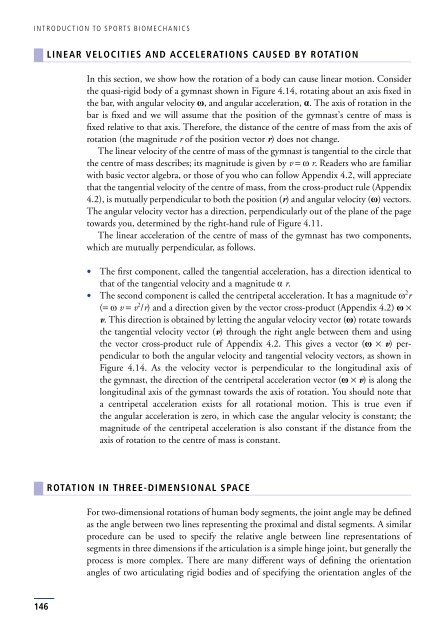Introduction to Sports Biomechanics: Analysing Human Movement ...
Introduction to Sports Biomechanics: Analysing Human Movement ...
Introduction to Sports Biomechanics: Analysing Human Movement ...
Create successful ePaper yourself
Turn your PDF publications into a flip-book with our unique Google optimized e-Paper software.
INTRODUCTION TO SPORTS BIOMECHANICS<br />
146<br />
LINEAR VELOCITIES AND ACCELERATIONS CAUSED BY ROTATION<br />
In this section, we show how the rotation of a body can cause linear motion. Consider<br />
the quasi-rigid body of a gymnast shown in Figure 4.14, rotating about an axis fixed in<br />
the bar, with angular velocity ω, and angular acceleration, α. The axis of rotation in the<br />
bar is fixed and we will assume that the position of the gymnast’s centre of mass is<br />
fixed relative <strong>to</strong> that axis. Therefore, the distance of the centre of mass from the axis of<br />
rotation (the magnitude r of the position vec<strong>to</strong>r r) does not change.<br />
The linear velocity of the centre of mass of the gymnast is tangential <strong>to</strong> the circle that<br />
the centre of mass describes; its magnitude is given by v = ω r. Readers who are familiar<br />
with basic vec<strong>to</strong>r algebra, or those of you who can follow Appendix 4.2, will appreciate<br />
that the tangential velocity of the centre of mass, from the cross-product rule (Appendix<br />
4.2), is mutually perpendicular <strong>to</strong> both the position (r) and angular velocity (ω) vec<strong>to</strong>rs.<br />
The angular velocity vec<strong>to</strong>r has a direction, perpendicularly out of the plane of the page<br />
<strong>to</strong>wards you, determined by the right-hand rule of Figure 4.11.<br />
The linear acceleration of the centre of mass of the gymnast has two components,<br />
which are mutually perpendicular, as follows.<br />
The first component, called the tangential acceleration, has a direction identical <strong>to</strong><br />
that of the tangential velocity and a magnitude α r.<br />
The second component is called the centripetal acceleration. It has a magnitude ω 2 r<br />
(= ω v = v 2 /r) and a direction given by the vec<strong>to</strong>r cross-product (Appendix 4.2) ω ×<br />
v. This direction is obtained by letting the angular velocity vec<strong>to</strong>r (ω) rotate <strong>to</strong>wards<br />
the tangential velocity vec<strong>to</strong>r (v) through the right angle between them and using<br />
the vec<strong>to</strong>r cross-product rule of Appendix 4.2. This gives a vec<strong>to</strong>r (ω × v) perpendicular<br />
<strong>to</strong> both the angular velocity and tangential velocity vec<strong>to</strong>rs, as shown in<br />
Figure 4.14. As the velocity vec<strong>to</strong>r is perpendicular <strong>to</strong> the longitudinal axis of<br />
the gymnast, the direction of the centripetal acceleration vec<strong>to</strong>r (ω × v) is along the<br />
longitudinal axis of the gymnast <strong>to</strong>wards the axis of rotation. You should note that<br />
a centripetal acceleration exists for all rotational motion. This is true even if<br />
the angular acceleration is zero, in which case the angular velocity is constant; the<br />
magnitude of the centripetal acceleration is also constant if the distance from the<br />
axis of rotation <strong>to</strong> the centre of mass is constant.<br />
ROTATION IN THREE-DIMENSIONAL SPACE<br />
For two-dimensional rotations of human body segments, the joint angle may be defined<br />
as the angle between two lines representing the proximal and distal segments. A similar<br />
procedure can be used <strong>to</strong> specify the relative angle between line representations of<br />
segments in three dimensions if the articulation is a simple hinge joint, but generally the<br />
process is more complex. There are many different ways of defining the orientation<br />
angles of two articulating rigid bodies and of specifying the orientation angles of the






